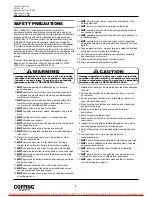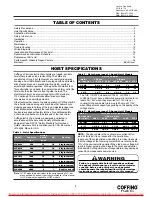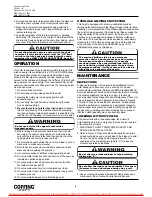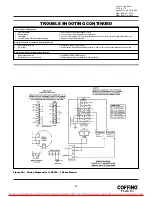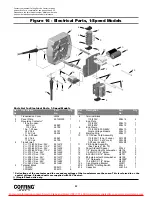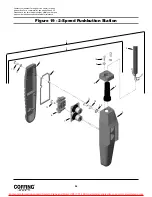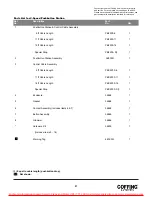
12
Country Club Road
P.O. Box 779
Wadesboro, NC 28170 USA
TEL: (800) 477-5003
FAX: (800) 374-6853
TROUBLE SHOOTING
Always disconnect unit from the power supply system before
removing hoist covers or the back cover of control station.
Failure to follow proper lockout/tagout procedures may
present the danger of electrical shock.
TO AVOID INJURY:
Disconnect power and lockout/tagout disconnecting
means before removing cover or servicing this
equipment.
1.
Limit switch not operating
1. Check adjustment (See LIMIT SWITCH ADJUSTMENT, page 8). Check connections against wiring diagram.
Tighten loose connections or replace.
2.
Brass limit switch nuts not moving on shaft
2. Check for stripped threads or bent nut guide.
3.
Hoist reversing contactor malfunctioning
3. Remove electrical cover and check reversing contactor.
Hook fails to stop at end of travel
1.
Power failure in supply lines
1. Check circuit breakers, switches and connections in power supply lines.
2.
Wrong voltage or frequency
2. Check voltage and frequency of power supply against the rating on the nameplate of the motor.
3.
Improper connections in hoist or pushbutton
3. Check all connections at line connectors and on terminal block. Check terminal block on dual voltage hoists for
station
proper voltage connections.
4.
Brake does not release
4. Check connections to the solenoid coil. Check for open or short circuit. Check for proper adjustment (See BRAKE
ADJUSTMENT, page 9).
5.
Faulty hoist reversing contactor
5. Check coils for open or short circuit. Check all connections in control circuit. Check for burned contacts.
Replace as needed.
Hoist does not respond to pushbutton
1.
Hoist overloaded
1. Reduce load to within rated capacity of hoist.
2.
Brake not holding
2. Check brake adjustment (See BRAKE ADJUSTMENT, page 9). It may be necessary to replace discs.
Hook does not stop promptly
1.
Three phase reversal
1. Reverse any two wires (except the green ground wire) at the power source (See INSTALLATION 3c, page 5).
2.
Improper connections
2. Check all connections against wiring diagram.
Hook moves in wrong direction
1.
“DOWN” circuit open
1. Check circuit for loose connections. Check “DOWN” limit switch for malfunction.
2.
Broken conductor in pushbutton cable
2. Check each conductor in the cable. If one is broken, replace entire cable.
3.
Faulty hoist reversing contactor
3. Check coils for open or short circuit. Check all connections in control circuit. Check for burned contacts.
Replace as needed.
4.
Loose screw clamps
4. Ensure that screw clamps are tightened on the terminal blocks and reversing contactor.
Hook raises but will not lower
1.
Hoist overloaded
1. Reduce load to within rated capacity of hoist.
2.
Low voltage
2. Determine cause of low voltage and bring up to within plus or minus 10% of the voltage specified on the motor.
Measure voltage at the hoist reversing contactor while lifting a load.
3.
“UP” circuit open
3. Check circuit for loose connections. Check “UP” limit switch for malfunction.
4.
Broken conductor in pushbutton cable
4. Check each conductor in the cable. If one is broken, replace entire cable.
5.
Faulty hoist reversing contactor
5. Check coils for open or short circuit, check all connections in control circuit. Check for burned contacts.
Replace as needed.
6.
Faulty capacitor (single phase hoist only)
6. Check starting capacitor on motor. Replace if necessary.
7.
Worn overload limiting clutch
7. Replace overload clutch assembly.
8.
Loose screw clamps
8. Ensure that screw clamps are tightened on the terminal blocks and reversing contactor.
Hook lowers but will not raise
––– Probable Cause –––
––– Remedy–––
1.
Hoist overloaded
1. Reduce load within rated capacity of hoist.
2.
Motor brake requires adjustment
2. Check motor brake adjustment (See BRAKE ADJUSTMENT, page 9).
3.
Worn overload limiting clutch
3. Replace clutch.
4.
Low voltage
4. Determine cause of low voltage and bring up to within plus or minus 10% of the voltage specified on the motor.
Measure voltage at the hoist reversing contactor while lifting a load.
5.
Faulty SINPAC
®
starting switch or start capacitor
5. Replace faulty component.
(single phase hoists only)
Hoist hesitates to lift when energized
1.
Excessive load
1. Reduce load to within rated capacity of hoist.
2.
Low voltage
2. Determine cause of low voltage and bring up to within plus or minus 10% of the voltage specified on the motor.
Measure voltage at the hoist reversing contactor while lifting a load.
3.
Extreme external heating
3. As the ambient temperature rises towards the 130°F limitation of the unit, frequency of the hoist operation must be
limited to avoid overheating of the motor. See ADVERSE ENVIRONMENTAL CONDITIONS, page 4.
4.
Frequent starting or reversing
4. Excessive inching, jogging or reversing should be avoided since this type of operation will drastically shorten the life
of motor, contactor and brake.
5.
Brake dragging
5. Check brake adjustment (See BRAKE ADJUSTMENT, page 9
).
Motor overheats
For more information contact: Sievert Crane and Hoist, (708) 771-1600, [email protected], www.sievertcrane.com


